
19th, 20th & 21st Century Fine Prints
707-546-7352 · fax 707-546-7924 · web: www.annexgalleries.com · email: artannex@aol.com
Four New Year's Greeting cards for 1953 - '56 by M.C. Escher
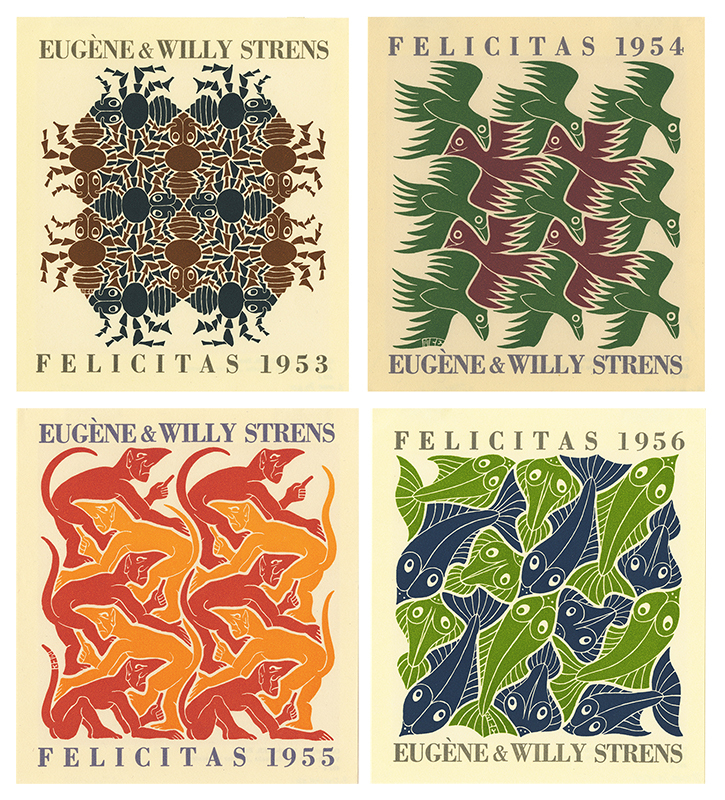
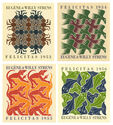
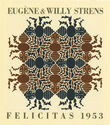
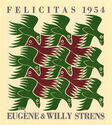
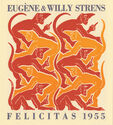
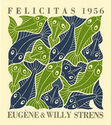

Four New Year's Greeting cards for 1953 - '56
M.C. Escher
Four New Year's Greeting cards for 1953 - '56
M.C. Escher
1898 - 1972 (biography)These four woodcuts are from a series illustrating the 'Four Elements': earth, air, fire, and water. All are color woodcuts with letterpress titles, commissioned by Dutch art patrons Eugène and Willy Strens as New Year’s greeting cards for the years 1953, 1954, 1955, and 1956. These cards are great examples of M.C. Escher’s mastery of optics and design.
Dutch engineer, amateur mathematician, meteorologist and astronomer, with an interest in art, chess and recreational mathematics, Eugène Strens was born in 1899 in Roermond in southern Netherlands. He was broadly educated in the Sciences and Humanities, eventually studying Electrical Engineering at the Delft Technische Hogeschool. He completed his studies after two years of military service but pursued his profession for only a short while being of independent means and having very wide-ranging interests.
In 1940 he married Hendrika "Willy" Wilhelmina te Strake. In 1943, he was forced to go underground as his brief time as a Dutch officer led to questioning by the Nazis. For the reminder of the war he and his family lived in secret, during which time Strens concentrated on mathematical theory and geometric puzzles. From 1945 on the Strens family lived in Breda, Netherlands, where Eugene died in 1980. He and Willy were friends and patrons of Dutch printmakers, including the mathematical artist Maurits Cornelis Escher, from whom they commissioned many works including these four greeting "cards".
Strens also maintained an active correspondence with fellow aficionados in all his areas of interest. He collected over eleven hundred books on chess, a hundred thousand Ex Libris (bookplates); a substantial collection of graphic art; over 2000 volumes on recreational mathematics; as well as newspaper clippings, periodicals and manuscripts.
Maurits Cornelis Escher was born on June 17, in Leeuwarden, Nethelands, the fourth and youngest son of George and Sara Escher. After five years the family moved to Arnhem, where he spent most of his youth. He was a sickly child and was placed in a special school at the age of seven; he failed the second grade. Although he excelled at drawing, his grades were generally poor. He took carpentery and piano lessons until he was thirteen years old. After he failed his final exam, and after a short interlude in Delft, M.C. Escher started with his lessons in architecture at the School of Architecture and Decorative Arts in Haarlem but after a week he informed his father that he wished to quit his architecture lessons and focus on studying graphic arts. He was supported in this by his teacher, printmaker Samuel Jesserun de Mesquita, to whom he had shown his drawings and linocuts.
After completing his school, he traveled through Italy, where he met his wife Jetta Umiker and who he married in 1924. They moved to Rome, where they lived until 1935. During these 11 years M.C. Escher traveled every year through Italy where he made drawings and sketches that he later used in his studio for his lithographs, woodcuts and wood engravings. During the time that he lived and worked in Italy, he created beautiful, more realistic works such as the "Castrovalva" litho in which one can see already his fascination for perspective: close, far, high and low. Likewise is the lithograph "Atrani", a small town on the Amalfi coast in Italy, which he made in 1931 and returned to in his masterpieces "Metamorphosis I and II."
He became famous for his so-called "impossible" drawings, such as "Ascending and Descending" and "Relativity", but also for his metamorphoses, such as "Metamorphosis I, II & III", "Sky and Water I" and "Reptiles." During his lifetime, Escher made 448 lithographs, woodcuts and wood engravings and more than 2000 drawings and sketches. Just like some of his famous predecessors – Michelangelo, Leonardo da Vinci, Dürer and Holbein – Escher was left-handed. In addition to his work as a graphic artist, he illustrated books, designs carpets and banknotes, stamps, murals, intarsia panels etc. Escher also became fascinated by the regular geometric figures of the wall and floor mosaics in the Alhambra, a fourteenth-century castle in Granada, Spain, which he visited in 1922 and 1936.
During his years in Switzerland and throughout the Second World War, he worked with great energy. He maked 62 of the 137 symmetrical drawings he will make in his life. He also expanded his hobby by using these symmetrical drawings for cutting wooden balls. He moved in 1937 to Belgium and in 1941 to Baarn, Netherlands. Maurits Cornelis Escher died in Hilversoum, Netherlands on March 27, 1972 at age 73.







